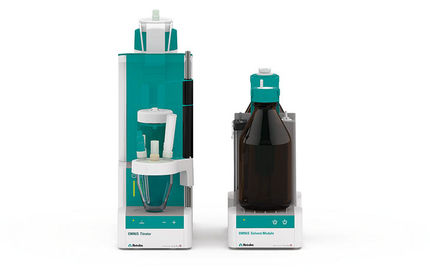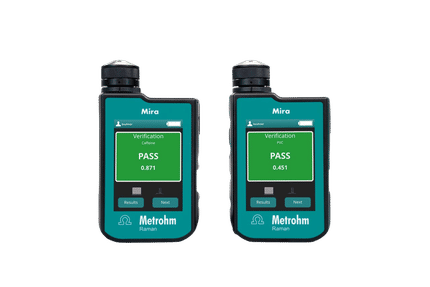EDTA is a widely-used abbreviation for the chemical compound ethylenediaminetetraacetic acid (and many other names, see table). EDTA refers to the chelating agent with the formula (HO2CCH2)2NCH2CH2N(CH2CO2H)2. This amino acid is widely used to sequester di- and trivalent metal ions. EDTA binds to metals via four carboxylate and two amine groups. EDTA forms especially strong complexes with Mn(II), Cu(II), Fe(III), and Co(III).[1]
Synthesis
EDTA is mostly synthesised from 1,2-diaminoethane (ethylenediamine), formaldehyde (methanal), water and sodium cyanide.[2] This yields the tetra sodium salt, which can be converted into the acidic forms by acidification.
Pioneering work on the development of EDTA was undertaken by Gerold Schwarzenbach in the 1940's.[3]
Popular vs. chemical nomenclature
To describe EDTA and its various protonated forms, chemists use a more cumbersome but more precise acronym that distinguishes between EDTA4−, the conjugate base that is the ligand, and H4EDTA, the precursor to that ligand.
Coordination chemistry principles
In coordination chemistry, H4EDTA is a member of the aminocarboxylate family of ligands that includes imidodiacetic acid ("H2IDA") and nitrilotriacetic acid ("H3NTA"). More specialized relatives include N,N'-ethylenediaminediacetic acid ("H2EDDA") and 1,2-diaminocyclohexane-N,N,N',N'-tetraacetic acid ("H4CyDTA"). These ligands are all formally derived from the amino acid glycine.
H4EDTA forms highly stable coordination compounds that are soluble in water. In these complexes, the ligand is usually either hexa- or pentadentate, EDTA4− or HEDTA3−, respectively. Such complexes are chiral, and [Co(EDTA)]− has been resolved into enantiomers.[4]
Uses
In 1999, the annual consumption of EDTA was equivalent to about 35,000 tons in Europe and 50,000 tons in the US.[citation needed] The most important uses are:
- Industrial cleaning: complexation of Ca2+ and Mg2+ ions, binding of heavy metals.
- Detergents: complexation of Ca2+ and Mg2+ (reduction of water hardness).
- Photography: use of Fe(III)EDTA as oxidizing agent.
- Pulp and paper industry: complexation of heavy metals during chlorine-free bleaching, stabilization of hydrogen peroxide.
- Textile industry: complexation of heavy metals, bleach stabilizer.
- Agrochemicals: Fe, Zn and Cu fertilizer, especially in calcareous soils.
- Hydroponics: iron-EDTA is used to solubilize iron in nutrient solutions.
More specialised uses of EDTA are:
- Food: added as preservative to prevent catalytic oxidation by metal ions or stabilizer and for iron fortification.[citation needed]
- Approved by the FDA as a preservative in packaged foods, vitamins, and baby food.
- Personal care: added to cosmetics to improve product stability.[citation needed]
- Oil production: added into the borehole to inhibit mineral precipitation.[citation needed]
- Dairy and beverage industry: cleaning milk stains from bottles.[citation needed]
- Flue gas cleaning: removal of NOx.
- Dentistry as a root canal irrigant to remove organic and inorganic debris (smear layer).
- Soft drinks containing ascorbic acid and sodium benzoate, to mitigate formation of benzene (a carcinogen).[citation needed]
- Recycling: recovery of lead from used lead acid batteries.
Medicine:
- EDTA is used in chelation therapy for acute hypercalcemia, mercury poisoning and lead poisoning[5].
- Combined with chromium, EDTA is used to evaluate kidney function. It is administered intravenously and its filtration into the urine is monitored. This method is considered the gold standard for evaluating glomerular filtration rate, Cr-EDTA's sole way out of the body is via glomerular filtration as it is not secreted or metabolised in any other way.
- Used as anticoagulant for blood samples
- In veterinary ophthalmology EDTA may be used as an anticollagenase to prevent the worsening of corneal ulcers in animals.
- Some laboratory studies also suggest that EDTA chelation may prevent collection of platelets ([or plaque] which can otherwise lead to formation of blood clots and prevent blood flow) on the walls of blood vessels [such as arteries]. These ideas are theoretical, however. [3]
In laboratory science, EDTA is also used for:
- Scavenging metal ions: in biochemistry and molecular biology, ion depletion is commonly used to inactivate metal-dependent enzymes which could damage DNA or proteins
- Complexometric titrations.
- Buffer solutions.
- Determination of water hardness.
- EDTA may be used as a masking agent to remove a metal ion which would interfere with the analysis of a second metal ion present
- An anticoagulant in medical and laboratory equipment.
- A preservative (usually to enhance the action of another preservative such as benzalkonium chloride or thiomersal) in ocular preparations and eyedrops. See "les conservateurs en opthalmologie" Doctors Patrice Vo Tan & Yves lachkar, Librarie Médicale Théa.
- A titrant used to determine nickel concentration in an electroless nickel plating bath.
- In metallography to remove staining due to etchants. Metal oxides are removed by gently swabbing with EDTA and rinsing in water.
- In cell cultures EDTA is used as a chelating agent which binds to calcium and prevents joining of cadhedrins between cells, preventing cell clumping. (often used in cell culture control).
Toxicity
- EDTA has been found to be both cytotoxic and weakly genotoxic in laboratory animals. Oral exposures have been noted to cause reproductive and developmental effects.
Environmental behavior
Widespread use of EDTA and its slow removal under many environmental conditions has led to its status as the most abundant anthropogenic compound in many European surface waters. River concentrations in Europe are reported as 10-100 μg/L, and lake concentrations are in the 1-10 μg/L range. EDTA concentrations in U.S. groundwater receiving wastewater effluent discharge have been reported at 1-72 μg/L, and EDTA was found to be an effective tracer for effluent, with higher concentrations of EDTA corresponding to a greater percentage of reclaimed water in drinking water production wells.
EDTA is not degraded or removed during conventional wastewater treatment. However, an adjustment of pH and sludge residence time can result in almost complete mineralization of EDTA. A variety of microorganisms have been isolated from water, soils, sediments and sludges that are able to completely mineralize EDTA as a sole source of carbon, nitrogen and energy.
Recalcitrant chelating agents such as EDTA are an environmental concern predominantly because of their persistence and strong metal chelating properties. The presence of chelating agents in high concentrations in wastewaters and surface waters has the potential to remobilize heavy metals from river sediments and treated sludges, although low and environmentally relevant concentrations seem to have only a very minor influence on metal solubility. Low concentrations of chelating agents may either stimulate or decrease plankton or algae growth, while high concentrations always inhibit activity. Chelating agents are nontoxic to many forms of life on acute exposure; the effects of longer-term low-level exposure are unknown. EDTA at elevated concentrations is toxic to bacteria due to chelation of metals in the outer membrane. EDTA ingestion at high concentrations by mammals changes excretion of metals and can affect cell membrane permeability.
Methods of detection and analysis
The most sensitive method of detecting and measuring EDTA in biological samples is selected-reaction-monitoring capillary-electrophoresis mass-spectrometry (abbreviation SRM-CE/MS) which has a detection limit of 7.3 ng/mL in human plasma and a quantitation limit of 15 ng/mL.[6] This method works with sample volumes as small as ~7-8 nL.[6]
EDTA has also been measured in non-alcoholic beverages using high performance liquid chromatography (HPLC) which has a detection limit of 0.6 μg/mL and a quantitation limit of 2.0 μg/mL.[7][8]
Forensics
- EDTA played a role in the O.J. Simpson trial when one of the blood samples collected from Simpson's estate was found to contain traces of the compound. This was used by the defense to indicate that the sample had been planted from one of the vials collected during the investigation. Prosecution claimed EDTA might have appeared in the sample as a result of eating McDonald's foods (either through bloodstream or, more likely, via contamination of blood flowing over the hand used in grabbing the food).
See also
References
- ^ Holleman, A. F.; Wiberg, E. (2001). Inorganic Chemistry. San Diego: Academic Press. ISBN 0-12-352651-5.
- ^ http://www.chm.bris.ac.uk/motm/edta/synthesis_of_edta.htm
- ^ http://www.chm.bris.ac.uk/motm/edta/edtah.htm
- ^ Kirchner, S. Barium (Ethylenediaminetetracetato) Cobalt(III) 4-Hydrate" Inorganic Syntheses, McGraw-Hill: New York, 1957; Vol. 5, pages 186-188.
- ^ Ruth DeBusk et al. (2002). Ethylenediaminetetraacetic acid (EDTA). Retrieved on 2007-07-25.
- ^ a b Robin L. Sheppard, and Jack Henion (1997). "Determining EDTA in Blood". Analytical Chemistry 69: 477A-480A. Retrieved on 2007-07-25.
- ^ S. Loyaux-Lawniczak, J. Douch, and P. Behra (1999). "Optimisation of the analytical detection of EDTA by HPLC in natural waters". Fresenius' J. Anal. Chem. 364 (8): 727-731. ISSN 0937-0633. Retrieved on 2007-07-25.
- ^ Carolina E. Cagnassoa, Laura B. López, Viviana G.
Rodríguez and Mirta E. Valencia (May 2006). "Development and validation of a method for the determination of EDTA in non-alcoholic drinks by HPLC". Journal of Food Composition and Analysis 20 (3-4). Retrieved on 2007-07-25.
http://www.ncbi.nlm.nih.gov/sites/entrez?cmd=Retrieve&db=PubMed&list_uids=12396676&dopt=AbstractPlus
| Antithrombotics (thrombolytics, anticoagulants and antiplatelet drugs) (B01) |
|---|
| Vitamin K antagonists | Acenocoumarol • Clorindione • Coumatetralyl • Dicumarol (Dicoumarol) • Diphenadione • Ethyl biscoumacetate • Phenprocoumon • Phenindione • Tioclomarol • Warfarin |
|---|
| Heparin group | Antithrombin III • Danaparoid • Heparin • Sulodexide • low molecular weight heparin (Bemiparin, Dalteparin, Enoxaparin, Nadroparin, Parnaparin, Reviparin, Tinzaparin) |
|---|
| Glycoprotein IIb/IIIa inhibitors | Abciximab • Eptifibatide • Tirofiban |
|---|
Other platelet
aggregation inhibitors | Acetylsalicylic acid/Aspirin • Aloxiprin • Ditazole • Carbasalate calcium • Cloricromen • Dipyridamole • Indobufen • Picotamide • Triflusal • ADP receptor inhibitors (Clopidogrel, Ticlopidine, Prasugrel) • prostaglandin analogue (Beraprost, Prostacyclin, Iloprost, Treprostinil) |
|---|
| Enzymes | plasminogen activators (Alteplase/Reteplase/Tenecteplase, Streptokinase, Urokinase/Saruplase, Anistreplase) • other serine endopeptidases (Ancrod, Drotrecogin alfa/Protein C, Fibrinolysin) • Brinase |
|---|
| Direct thrombin inhibitors | Argatroban • Bivalirudin • Dabigatran • Desirudin • Hirudin • Lepirudin • Melagatran • Ximelagatran |
|---|
| Other antithrombotics | Defibrotide • Dermatan sulfate • Fondaparinux • Rivaroxaban |
|---|
| Non-medicinal | Citrate • EDTA • Oxalate |
|---|
|







